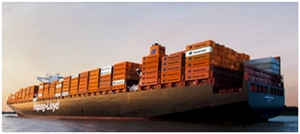European regulator conditionally approves Hapag-Lloyd- United Arab Shipping merger
24 Nov 2016
The European regulator yesterday conditionally approved the merger between German container shipping line Hapag-Lloyd AG and the United Arab Shipping Company (UASC).
"Both companies operate in the container liner shipping sector," the European Commission (EC) said in a statement. "The clearance is conditional on the withdrawal of UASC from a consortium on the trade routes between Northern Europe and North America, where the merged entity would have faced insufficient competitive constraint."
In June, Hapag-Lloyd agreed to a merger with Dubai's UASC in order to create the world's fifth-largest container shipping line with an estimated value of €8.2 billion. (See: Germany's Hapag-Lloyd to merge with Dubai's United Arab Shipping Company)
UASC is owned by several Middle East sovereign wealth funds, including Qatar Investment Authority, which holds 51 per cent, Saudi Arabia's Public Investment Fund holds 36 per cent, while Kuwait and United Arab Emirates hold minority stakes.
Hapag-Lloyd, the world's sixth-biggest container operator, has a fleet of 175 vessels, while UASC is the tenth-biggest, has 55 vessels.
The merged company would have a fleet of around 230 vessels with a capacity of around 1.5 million twenty-foot equivalent units and hold a 7.4 per cent global market share.
The merged company will join The Alliance of Hanjin Shipping, Hapag-Lloyd, ''K'' Line, MOL, NYK Line and Yang Ming Line, which would have benefitted from UASC's fleet of mega-ships, and increase its competitiveness on major east-west trades.
The Alliance partners include Japan's Kawasaki Kisen Kaisha Ltd., Mitsui OSK Lines Ltd., Nippon Yusen KK, South Korea's Hanjin Shipping Co. and Taiwan's Yang Ming Marine Transport Corp and Hapag-Lloyd.
The Alliance controls 18 per cent of the world's container shipping fleet with more than 620 vessels and a combined capacity of 3.5 million standard twenty-foot containers, or TEU.
The EC said that like several other carriers, UASC and Hapag-Lloyd offer their services on trade routes mainly through cooperation agreements with other shipping companies, known as "consortia" or "alliances".
Consortia and alliance members decide jointly on capacity setting, scheduling and ports of call, which are all important parameters of competition. The EC said that it examined the effects of the merger on competition in the market for container liner shipping on thirteen trade routes connecting Europe with the Americas, the Middle East, the Indian Subcontinent, the Far East, Australia, New Zealand and West Africa, as well as Northern Europe with the Mediterranean.
The EC found that the merger would have created links on the Northern Europe – North America trade routes between the consortia and alliances in which Hapag-Lloyd is a member and the NEU1 (ex-Pendulum) consortium, in which UASC is a member. As a result, through the consortia and alliances it would belong to, the merged entity could have influenced capacity and prices on a very large part of those markets, to the detriment of customers and, ultimately, consumers.
The EC had concerns that on those routes, the merged entity would have faced insufficient competitive constraint from rival companies.
In order to address the EC's concerns, Hapag-Lloyd offered to terminate the participation of UASC in the NEU1 consortium. This will entirely remove the additional link between Hapag-Lloyd's and UASC's consortia, that the transaction would have created on the Northern Europe – North America trade routes.